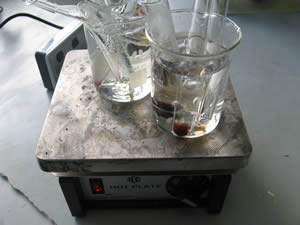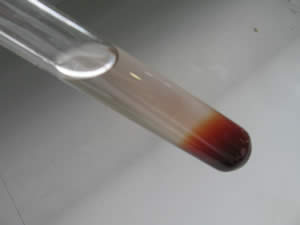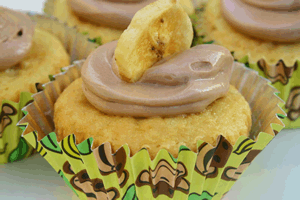Ester formation activity
We can prepare esters from alcohols and organic acids.
We will need dropping bottles
of :
- ethanol
- propanol
- butanol
- pentanol
- methanol
- ethanoic acid
- concentrated sulfuric acid
and a bottle of salicylic acid, 10mL measuring cylinder, 6 test tubes
250 mL beaker, hotplate,
Step
1 - Set up a 250 mL beaker two thirds full of water on a hotplate. This
will serve as a water bath as shown on the right.
Step 2 - Add 2 mL of alcohol and 2 mL of organic acid according to the
table below.
Step 3 - Add two drops of concentrated sulfuric acid to the mixture in
the test tube.
Step 4 - Place the test tube in the water bath until the mixture starts
to bubble. Continue moderate heating for 5 minutes.

The ester may be seen forming in the test tube.

After 5 minutes of moderate heating remove the test tube from the water bath and empty the contents into a beaker half full of cold water, as shown on the right. Now bring the beaker closer to your nose and with your hand waft some of the fumes above the beaker towards your nose.
Alcohol |
Organic
acid |
Smell |
||
| Ethanol | Ethanoic acid | |||
| Methanol | Salicylic acid (0. 1 gram) | |||
| Propanol | Ethanoic acid | |||
| Butanol | Ethanoic acid | |||
| Pentanol | Ethanoic acid | |||
Name each ester.
Compare the odour of each ester formed.
Sulfuric acid was added as a catalyst. What was the role of the sulfuric acid?
Describe a method that can be used to recover the ester from the mixture in the test tube. Hint
Worksheet for senior Chemistry
Many of the processed foods that you buy today come with an ingredient label that lists "artificial flavors" as one of the key ingredients. Artificial flavors are simply chemical mixtures that mimic a natural flavor in some way. A food with a picture of a banana on the label must contain bananas. If it contained banana flavouring rather than real bananas, it must be labeled as 'banana-flavoured'. Banana flavouring is composed predominantly of the chemical isoamyl acetate.
Anything that we smell has to contain some sort of volatile chemical. That is a chemical that easily evaporates at room temperature and comes in contact with sensory cells in the nose.

Any natural flavour is normally quite complex, with many chemicals interacting to create the taste or smell. However, many fruit flavours have just one or a few dominant chemical components that carry the bulk of the distinctive taste or smell.
Many of these chemicals are esters. For example, the ester called Octyl Acetate (CH3COOC8H17) is a fundamental component in orange flavor. The ester called isoamyl acetate (CH3COOC5H11) is a fundamental component of banana flavor. If you add these esters to a product, the product will taste, to some degree, like orange or banana. To make more realistic flavors you add other chemicals in the correct proportions to get closer and closer to the real thing. You can do that by trial and error or by chemical analysis of the real thing.
There are hundreds of chemicals known to be flavoring agents. It's interesting that they are normally mixed to create "known" tastes. People make artificial grape, cherry, orange, banana, apple, etc. flavors, but it is very rare to mix up something that no one has ever tasted before. But it can and does happen occasionally -- take Juicy Fruit gum as an example!

All flavours can be created by
A chemical that is used to give a banana smell to icecream is said to be volatile.
Explain the term volatile?
Why must this chemical be volatile?